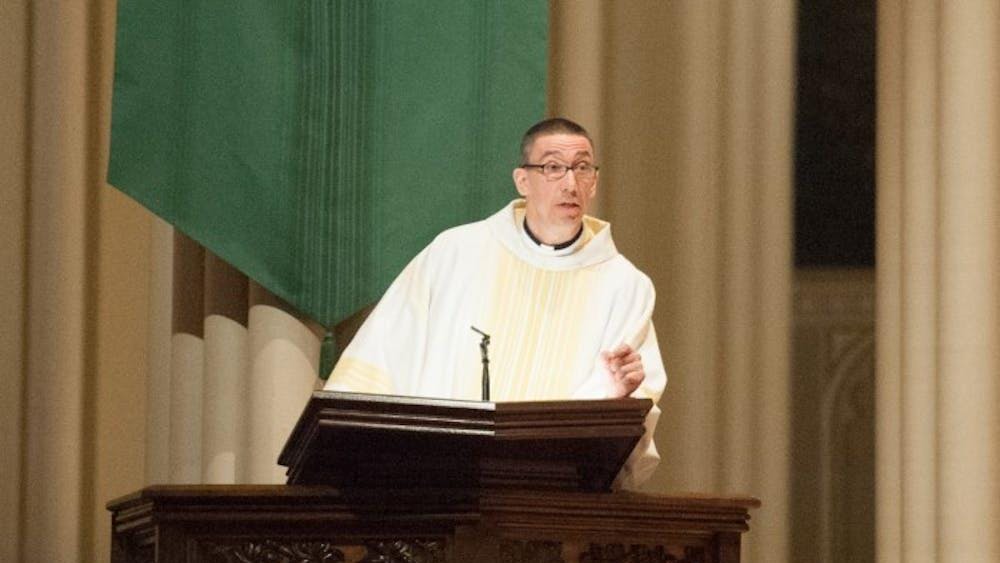Editor's note: This is the first in a five-day series discussing the role of women at Notre Dame and Saint Mary's, in honor of the 40th anniversary of coeducation at the University this year.
As Notre Dame celebrates 40 years of coeducation, Saint Mary's alumnae still remember a time when the two schools considered merging to create one Catholic college for both men and women under the Holy Cross order.

While the merger fell apart in 1971, College archivist John Kovach said he believes the merger was a good idea at first.
"At the time I definitely think it made sense to merge," Kovach said. "In theory, however, the colleges quickly found out that no one wanted to lose and in situations such as this, one college was going to lose.
"When looking at this era of the merger there were over 300 women's colleges, that number has increasingly gone down. Today, it is a very unique choice to come to a women's college."
A spring 1983 issue of The Courier, Saint Mary's alumnae magazine, offered a timeline of the events leading up to the failed merger.
Beginning in September 1965, the universities introduced a new co-exchange program through which students could take courses at either college, the timeline stated. This program marked a new beginning for the long-standing relationship of the two campuses since crossover classes for students on the neighboring campuses had not been an opportunity before.
By May of 1969, Saint Mary's and Notre Dame agreed to expand the co-exchange program. The colleges modified the freshman liberal arts curriculum to be consistent across campuses, introduced integrated dining options and seating at athletic events and synced academic calendars.

While these measures hinted at a potential merger, both University President Emeritus Fr. Theodore Hesburgh and President Emeritus Monsignor John McGrath, presidents of the respective colleges at the time, issued a joint statement denying any rumors of a merger at the time.
Senior Jessica Lopez, who studied the non-merger for over a year for her senior comprehensive project, said she believes the colleges considered the merger primarily for the benefit of Notre Dame students' gender relations.
"I found that it seemed what Notre Dame was interested in was what all-male colleges used in order to combine with a sister school," Lopez said. "They would say they wanted to use the merger to act as a civilizing influence to prepare for real world interactions with women. Saint Mary's would have given those benefits to Notre Dame."
In her findings, Lopez saw a diversity of opinions among students and faculty at the time.
"There were some strong sentiments from students and some faculty," Lopez said. "Some didn't consider it a good option for Saint Mary's. Even at Notre Dame people were against the merger. Fr. James Burtchaell, provost at Notre Dame during that time, asserted that Notre Dame did not need to merge with Saint Mary's, but rather the College needed to merge with Notre Dame to survive."
According to the timeline, in May of 1971, the Boards of Trustees at both institutions formally approved plans to seek unification. According to a statement from that time, "the ultimate goal of this unification is a single institution with one student body of men and women, one faculty, one president and administration and one board of trustees."
The statement noted the preservation of Saint Mary's identity would be by the matriculation of all women undergraduates of the University through Saint Mary's as the college of record. It also recognized the importance of financial viability of any plan to merge the two institutions.
According to a statement from the Board of Trustees from Notre Dame and Saint Mary's, the ultimate goal of this unification was to form a single institution with one student body of men and women, one faculty, one president and administration and one Board of Trustees.
"Unification of all academic departments of ND and SMC should be accomplished by the start of 1972-73," the statement said. "The academic year 1974-75 is the target date for the completion of unification, but it is hoped that it might be accomplished even before that time."
However, by November of 1971, Mother Olivette Whalen and Edmund Stephan, chairpersons of the Saint Mary's and Notre Dame Board of Trustees, respectively, issued a joint statement announcing the two institutions would "indefinitely suspend unification negotiation," because organizers were "unable to solve financial and administrative problems."
Reconciling the financial differences between the two school's budgets and pay to their employees, as well as the logistics in combining all the schools' academic programs without losing any employees, became too difficult.
Soon after, Notre Dame announced plans to begin accepting women directly.
"Things started falling through," Lopez said. "By December, all negotiations broke down. The administrations sent a letter to female applicants saying they could apply to both Notre Dame and Saint Mary's or one or the other. There was another attempt to reopen negotiations the next year but nothing happened."
While a second attempt at a merger would be made the following year, Kovach said nothing materialized.
"I think for something that is so important to the history of Saint Mary's, I am surprised that so many decades later there still seems to be this aura of silence around the subject," Kovach said. "The non-merger, I think, is the most important part of our college. We wouldn't be here today, at least in this setting. We really bucked a trend and have proved successful. This success, I think is due to the leadership at the college. A merger wouldn't have been an equal setting at all."
"There was a slow movement and sad decline in interest," Lopez said. "Overall, there was no climactic point to the merger becoming a non-merger, the outcome just slopes downward."
Many students of the Class of 1975 accepted the offer to come to Saint Mary's under the assumption the College would be merging with Notre Dame their freshman year, however. This caused for mixed feelings among the student body.
"Mostly I remember the anger, disappointment and frustration when the merger didn't go through," Mary Meruisse Richardson, a 1975 alumna, said. "I remember the song, 'There's a Riot Going On' wafting out from dorm windows. I felt betrayed because I had accepted to come expecting the merger to go through and then it didn't. When the merger fell apart, many of my friends transferred to ND. It split up our class and that was hard."
Mary-Margaret Anthonie Ney, also a 1975 alumna, said emotions ran high after the non-merger went public.
"In some old editions of The Observer they covered many protests. We even made national news," Ney said. "When it first happened, there was lot of resentment. ... We never really heard a good explanation for why it was called off. It settled down after a while, though, and people made decisions. I chose to stay at Saint Mary's as [a] Spanish major, which worked out really well for me. My roommate transferred to Notre Dame because her major found a better fit there."
Class of 1975 alumna Jeanne Murabito said at first she had mixed feelings about the merger cancellation, but later decided she was pleased with the outcome.
"I knew I could take classes at Notre Dame and be a part of that social life," Murabito said. "I chose not to transfer after my freshman year although some of my friends did. At first I was upset about it, but now I realize I had the best of both worlds. I was a humanistic studies major and I couldn't get that anywhere else. The professors' personal commitment to the College was extraordinary. I do not regret my decision to stay at the College."
Amy Dardinger, assistant director of reunion giving, said many alumna from the Class of 1975 are overcoming the emotions of the non-merger and are giving back to the College more.
"Many of them have come to the point that they appreciate that Saint Mary's is still here," she said.
Because many women's colleges merged with brother institutions at this time, most alumnae of these institutions find themselves returning to a fundamentally different college.
"Now I think many alums return to the College and think 'How lucky are we that we are able to return to a single-sex institution?'" Kovach said. "So many women's colleges at this time merged with partner institutions and I think Saint Mary's is very lucky to have not merged. I think that time has made some folks open their eyes to what the consequences of the merger really could have been. This really shaped the identity of the College."
Many alumnae of the college and that Class of 1975 said they are thankful Saint Mary's remained independent.
"It worked out very well for me," Ney said. "I love Saint Mary's, it's a great place and I felt like I grew up there and became my own person. I am still very proud of Saint Mary's."
Contact Jillian Barwick at jbarwi01@saintmarys.edu and Kaitlyn Rabach at krabac01@saintmarys.edu











